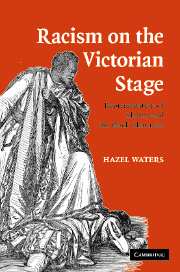Book contents
- Frontmatter
- Contents
- List of illustrations
- Acknowledgements
- Introduction
- 1 From vengeance to sentiment
- 2 The beginning of the end for the black avenger
- 3 Ira Aldridge and the battlefield of race
- 4 The comic and the grotesque: the American influence
- 5 The consolidation of the black grotesque
- 6 Slavery freed from the constraint of blackness
- 7 Uncle Tom – moral high ground or low comedy?
- Afterword
- Notes
- Bibliography
- Index
2 - The beginning of the end for the black avenger
Published online by Cambridge University Press: 22 September 2009
- Frontmatter
- Contents
- List of illustrations
- Acknowledgements
- Introduction
- 1 From vengeance to sentiment
- 2 The beginning of the end for the black avenger
- 3 Ira Aldridge and the battlefield of race
- 4 The comic and the grotesque: the American influence
- 5 The consolidation of the black grotesque
- 6 Slavery freed from the constraint of blackness
- 7 Uncle Tom – moral high ground or low comedy?
- Afterword
- Notes
- Bibliography
- Index
Summary
Enjoyable and successful as Inkle and Yarico (1787) was, and despite its sustained popularity, it did not usher in a more nuanced approach to the image of the black character presented for popular consumption; rather, there was a deterioration, though this is not immediately apparent. As the nineteenth century opened, the same basic dramatic fare that had been available for the past fifty years and more still continued to be played, masking a process of change that can be seen only in retrospect. What gradually becomes clear is that the type of drama derived from abolitionist sentiment, such as George Colman's The Africans (1809), declines and the classic expression of black nobility in Oroonoko degrades, evidenced in the 1806 published version of the play (reprinted in 1834), its 1817 revival and Thomas Morton's 1816 reworking of it as The Slave. There is a corresponding decline in the forcefulness of the figure of the black avenger, evidenced in Douglas Jerrold's Descart, the French Buccaneer (1828) and C. P. Thompson's Jack Robinson and his Monkey (1829), coupled with an increasingly emphatic national self-congratulation over Britain's role in the abolition of the slave trade, as in Morton's The Slave and J. T. Haines's My Poll and my Partner Joe (1835).
The long and bitter years of war with Napoleonic France, only finally concluded by 1815, and carried out against a domestic background of burgeoning industrial and economic change, engendered an emphasis on the peculiarly English nature of liberty as the birthright of all classes of its people, to be sharply distinguished from foreign republican and Jacobin notions, that sounded throughout much of popular drama.
- Type
- Chapter
- Information
- Racism on the Victorian StageRepresentation of Slavery and the Black Character, pp. 37 - 57Publisher: Cambridge University PressPrint publication year: 2007



